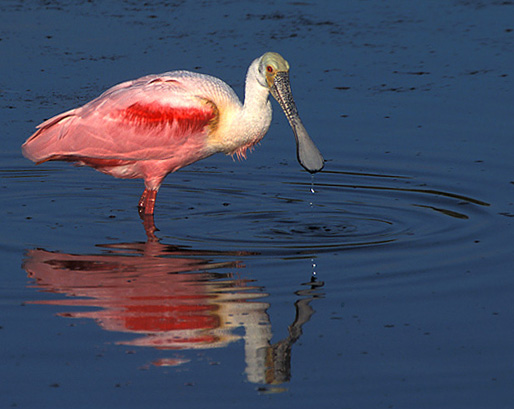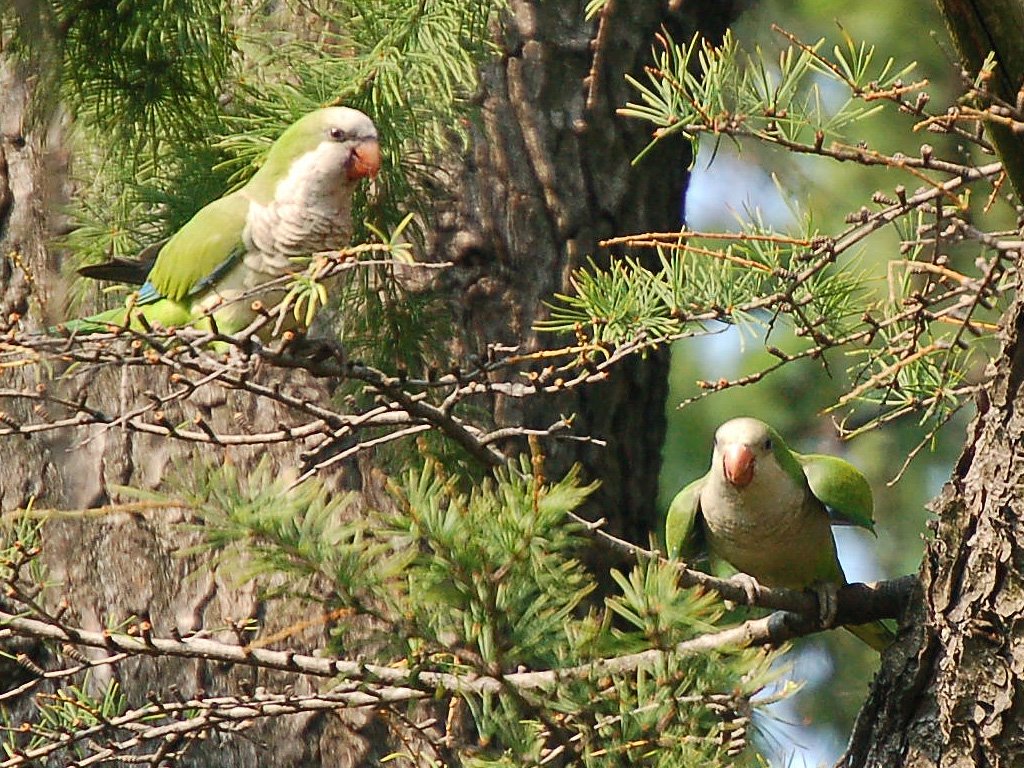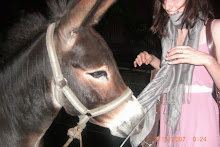I've been reading Mark A Hall's book on Thunderbirds about the possibility that today there exist giant eagles mentioned in Native American lore, big enough to carry off a child (as allegedly happened in 1977 in Illinois). Many bird experts refute the possibility that a bird or eagle would attack a human, or have the ability to actually kill or pick up a child.
Just yesterday, StrangeArk.com had a link to a new article about how anthropologists have just said that there is strong evidence that eagles killed and attacked early human ancestors. The scars on the skull of an Australopithecus africanus toddler are more in line with the marks of an eagle attack than a saber tooth tiger, as was originally thought to be the culprit. Also, it was recently discovered from investigating the discarded bones in eagle nests, that these African crowned hawk eagles have been eating mangabey monkeys on a regular basis.
Just saying...
Thursday, August 31, 2006
Monday, August 28, 2006
Supply and demand in Miami
I was very excited to learn that Micky's father had seen this site. In honor of my favorite new reader, I'd like to talk about some of the birds of Professor H's hometown - Miami.
SouthFloridaBirding.com seems to be a helpful site for tips on places to birdwatch, as well as Birding.com/wheretobird/Florida. The SouthFloridaBirding site has a nice photo gallery, and I found myself stuck in a little quandary while looking at the images. Because of Miami's warm climate, it allows for some of the more colorful, almost tropical looking birds to live there. So I assumed that there would be some weird, unusual looking birds, such as the roseate spoonbill. But some of the birds in the pictures were birds that I really didn't think were at all native to Florida, not even North America.
Roseate Spoonbill:

My first tip was that several parrots photos were on the site. The only parrot species to be native to North America was the Carolina parakeet, which has been extinct for over 100 years. However, there are plenty of parrots that have escaped from captivity and have bred in the wild. There's even a flock of monk (also known as quaker) parrots living in the gate of the cemetery here in Brooklyn - BrooklynParrots.com.
One of the pictures of the hill myrna really caught my eye - the birds seemed familiar to me from guide books, but yet I really didn't think it could actually be native to Florida.
Hill Mynas in Miami:


Turns out it is actually a native of southeast Asia and India. It is popular as a pet bird, because it can talk. This couple set up a whole website dedicated to pet mynas, and warning other owners of the "iron storage disease" that claimed their own beloved pet - Mynahbird.com.
Here's a little more info on escaped pet birds:
"The Monk Parakeet is considered a major agricultural pest in its native Argentina. That reputation, coupled with reports in the popular press putting the U. S. feral population at 4,000 to 5,000 birds, led to a coordinated eradication program, especially in New York, New Jersey, California, and Virginia. The program was highly successful, and small feral populations now persist only in a few Florida locations and in Chicago. In retrospect, the fears may have been groundless. The actual number of feral birds probably was overestimated considerably, and population expansion was mostly confined to the metropolitan New York area, with lesser numbers in Florida, Pennsylvania, and Illinois. Nonetheless, it has been estimated that the Monk Parakeet could cause millions of dollars in agricultural losses should it become abundant.
Members of the parrot family are not the only cage birds to have gone feral in the mainland United States. Red-whiskered Bulbuls (passerines related to kinglets), from southeast Asia, escaped from a bird farm near Miami around 1960. The species, at last report, occupied about three square miles and was slowly spreading. Escaped bulbuls also established feral populations in the Los Angeles area, where attempts have been made to eliminate them by shooting. The Java Finch and Indian Hill Myna, both popular as pets, are also feral in the Miami area. The Spot-breasted Oriole from Central America is also well established in southeastern Florida following escapes from captivity. The most spectacular feral bird in the United States, however, is the Greater Flamingo. This Caribbean species has repeatedly escaped from captive flocks in Florida, and a free-flying colony lives around Hialeah Race Track in Miami."
from: http://www.stanford.edu/group/stanfordbirds/text/essays/Feral_Birds.html
A veterinarian I met at a party once explained to me about how the monk parakeets living in the Brooklyn cemetery are an example of the ecological "niche theory". The idea is that North America as an ecosystem is capable of sustaining one species of parrot. Until recently, that was the carolina parakeet, and after that species became extinct, this opened up a niche for a different parrot species, this time non-native, to fit in. Since monk parakeets come from a similar latitude in the southern hemisphere, they were able to fill this niche and thrive.
This seems related to economic markets, which Mr. Hervitz is an expert on. If there is sustainable niche in a market for something, if one company folds for some reason, there's room for another company to come in and fills that place in the market. Though in the case of parrots in North America, the marketplace has changed, and now there less demand for parrots, and more demand not having eating all our crops eaten by pesky parrots.
Thankfully, Prof. Hervitz is a much more welcome transplant from Argentina to Miami.
Monk Parakeets in the Brooklyn cemetary:

SouthFloridaBirding.com seems to be a helpful site for tips on places to birdwatch, as well as Birding.com/wheretobird/Florida. The SouthFloridaBirding site has a nice photo gallery, and I found myself stuck in a little quandary while looking at the images. Because of Miami's warm climate, it allows for some of the more colorful, almost tropical looking birds to live there. So I assumed that there would be some weird, unusual looking birds, such as the roseate spoonbill. But some of the birds in the pictures were birds that I really didn't think were at all native to Florida, not even North America.
Roseate Spoonbill:

My first tip was that several parrots photos were on the site. The only parrot species to be native to North America was the Carolina parakeet, which has been extinct for over 100 years. However, there are plenty of parrots that have escaped from captivity and have bred in the wild. There's even a flock of monk (also known as quaker) parrots living in the gate of the cemetery here in Brooklyn - BrooklynParrots.com.
One of the pictures of the hill myrna really caught my eye - the birds seemed familiar to me from guide books, but yet I really didn't think it could actually be native to Florida.
Hill Mynas in Miami:

Turns out it is actually a native of southeast Asia and India. It is popular as a pet bird, because it can talk. This couple set up a whole website dedicated to pet mynas, and warning other owners of the "iron storage disease" that claimed their own beloved pet - Mynahbird.com.
Here's a little more info on escaped pet birds:
"The Monk Parakeet is considered a major agricultural pest in its native Argentina. That reputation, coupled with reports in the popular press putting the U. S. feral population at 4,000 to 5,000 birds, led to a coordinated eradication program, especially in New York, New Jersey, California, and Virginia. The program was highly successful, and small feral populations now persist only in a few Florida locations and in Chicago. In retrospect, the fears may have been groundless. The actual number of feral birds probably was overestimated considerably, and population expansion was mostly confined to the metropolitan New York area, with lesser numbers in Florida, Pennsylvania, and Illinois. Nonetheless, it has been estimated that the Monk Parakeet could cause millions of dollars in agricultural losses should it become abundant.
Members of the parrot family are not the only cage birds to have gone feral in the mainland United States. Red-whiskered Bulbuls (passerines related to kinglets), from southeast Asia, escaped from a bird farm near Miami around 1960. The species, at last report, occupied about three square miles and was slowly spreading. Escaped bulbuls also established feral populations in the Los Angeles area, where attempts have been made to eliminate them by shooting. The Java Finch and Indian Hill Myna, both popular as pets, are also feral in the Miami area. The Spot-breasted Oriole from Central America is also well established in southeastern Florida following escapes from captivity. The most spectacular feral bird in the United States, however, is the Greater Flamingo. This Caribbean species has repeatedly escaped from captive flocks in Florida, and a free-flying colony lives around Hialeah Race Track in Miami."
from: http://www.stanford.edu/group/stanfordbirds/text/essays/Feral_Birds.html
A veterinarian I met at a party once explained to me about how the monk parakeets living in the Brooklyn cemetery are an example of the ecological "niche theory". The idea is that North America as an ecosystem is capable of sustaining one species of parrot. Until recently, that was the carolina parakeet, and after that species became extinct, this opened up a niche for a different parrot species, this time non-native, to fit in. Since monk parakeets come from a similar latitude in the southern hemisphere, they were able to fill this niche and thrive.
This seems related to economic markets, which Mr. Hervitz is an expert on. If there is sustainable niche in a market for something, if one company folds for some reason, there's room for another company to come in and fills that place in the market. Though in the case of parrots in North America, the marketplace has changed, and now there less demand for parrots, and more demand not having eating all our crops eaten by pesky parrots.
Thankfully, Prof. Hervitz is a much more welcome transplant from Argentina to Miami.
Monk Parakeets in the Brooklyn cemetary:

Thursday, August 17, 2006
Mystery bustards
I recalled on recent trip the American Museum of Natural History that in the hall of birds, in the display window for birds of the African Savannah, there was some strange looking bird that was listed as extinct on the label card, and I had tried to make a note to look into it. I thought that it was some kind of bustard, but when I tried to do some internet searching for a type of extinct bustard, I came up with nothing. It seems that all species of bustard are alive and (relativelty) well.
The most interesting thing I came across was a site all about a program to re-introduce the Great Bustard to England where it once lived. The website greatbustard.com, which has some pertty hilariously bad web design, tells how the bird became excinct in Britain by 1832, but thrived elsewhere. Apparently, bustard eggs are being taken from Russia and transported over to Salsibury Plain to hatch.
Great Bustard:

I'm wondering what examples of re-introduced species have been successful. California condors in Arizona is probably the best example I can think of. Grey wolves? That actually seems more like a failure story, with people hating having more wolves around.
Anyway, back to the mystery at the Natural History Museum. I emailed Marylou Murrillo, who works in the textiles department of the AMNH. I asked her if she could take a look at the African birds case adn check it out for me. What she found was that there is a Denham's Bustard in the case, and it is listed as critically endangered.
I had some trouble finding information about Denham's Bustard (formerly known as Stanley's bustard) on the internet, but I did find that 13 different stamps depicting the Denham's bustard from 5 African countries have been issued since 1951.
Angolan stamp:

The most interesting thing I came across was a site all about a program to re-introduce the Great Bustard to England where it once lived. The website greatbustard.com, which has some pertty hilariously bad web design, tells how the bird became excinct in Britain by 1832, but thrived elsewhere. Apparently, bustard eggs are being taken from Russia and transported over to Salsibury Plain to hatch.
Great Bustard:

I'm wondering what examples of re-introduced species have been successful. California condors in Arizona is probably the best example I can think of. Grey wolves? That actually seems more like a failure story, with people hating having more wolves around.
Anyway, back to the mystery at the Natural History Museum. I emailed Marylou Murrillo, who works in the textiles department of the AMNH. I asked her if she could take a look at the African birds case adn check it out for me. What she found was that there is a Denham's Bustard in the case, and it is listed as critically endangered.
I had some trouble finding information about Denham's Bustard (formerly known as Stanley's bustard) on the internet, but I did find that 13 different stamps depicting the Denham's bustard from 5 African countries have been issued since 1951.
Angolan stamp:

Subscribe to:
Posts (Atom)



